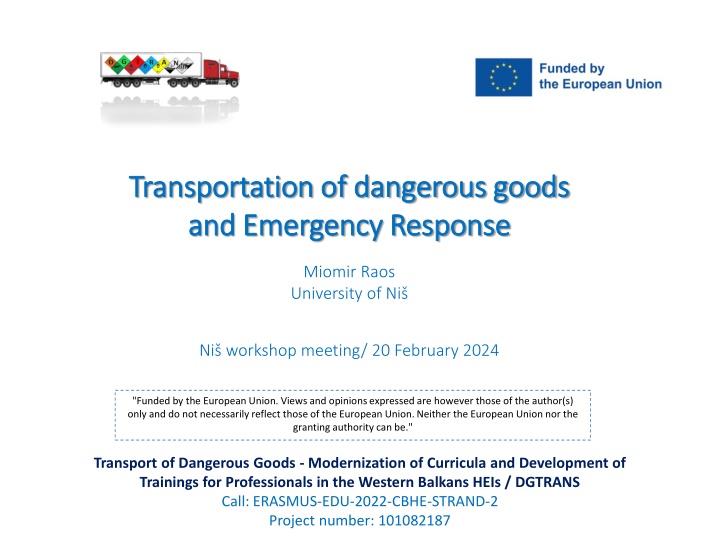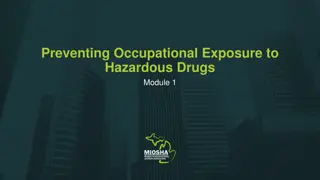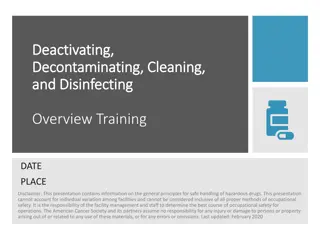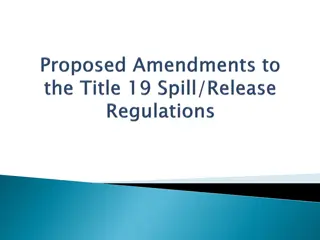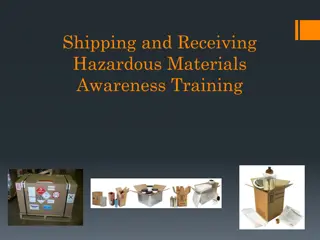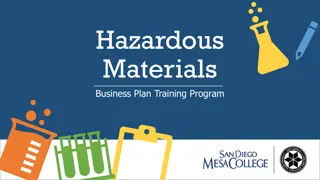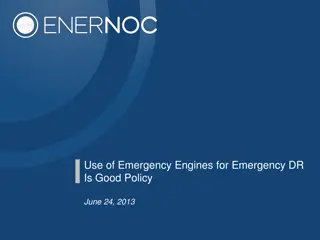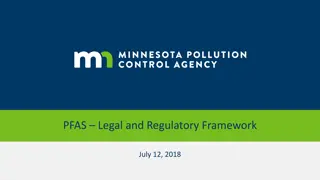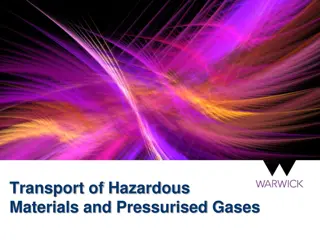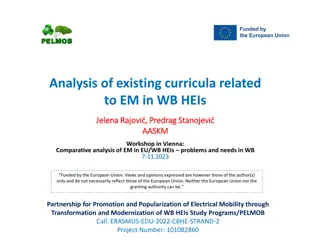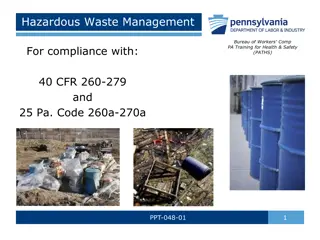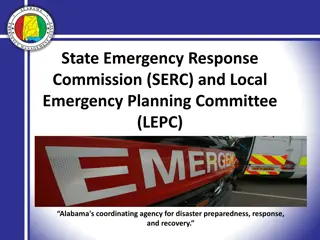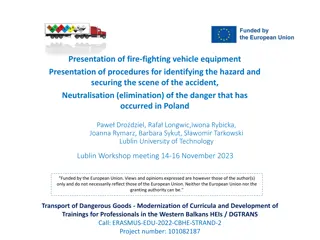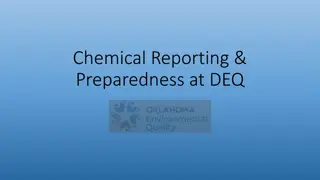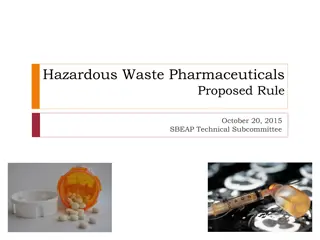Modernization of Curricula for Transportation of Hazardous Materials and Emergency Response Workshop
This workshop, funded by the European Union, focuses on modernizing curricula and developing training programs for professionals in the Western Balkans HEIs on the transportation of dangerous goods and emergency response. Various methods of transporting hazardous materials, such as cargo tanks, chemical haulers, and roadway vehicles, are discussed along with safety features and best practices. The event aims to enhance knowledge and skills in handling hazardous materials effectively and safely.
Download Presentation

Please find below an Image/Link to download the presentation.
The content on the website is provided AS IS for your information and personal use only. It may not be sold, licensed, or shared on other websites without obtaining consent from the author.If you encounter any issues during the download, it is possible that the publisher has removed the file from their server.
You are allowed to download the files provided on this website for personal or commercial use, subject to the condition that they are used lawfully. All files are the property of their respective owners.
The content on the website is provided AS IS for your information and personal use only. It may not be sold, licensed, or shared on other websites without obtaining consent from the author.
E N D
Presentation Transcript
Transportation of dangerous goods Transportation of dangerous goods and Emergency Response and Emergency Response Miomir Raos University of Ni Ni workshop meeting/ 20 February 2024 "Funded by the European Union. Views and opinions expressed are however those of the author(s) only and do not necessarily reflect those of the European Union. Neither the European Union nor the granting authority can be." Transport of Dangerous Goods - Modernization of Curricula and Development of Trainings for Professionals in the Western Balkans HEIs / DGTRANS Call: ERASMUS-EDU-2022-CBHE-STRAND-2 Project number: 101082187
Transporting Hazardous Materials Roadway transportation vehicles Transport of Dangerous Goods - Modernization of Curricula and Development of Trainings for Professionals in the Western Balkans HEIs / DGTRANS
Transporting Hazardous Materials Transport of hazardous materials (air, sea, or land, or a combination of any) Roadway transportation vehicles - the most common method of hazardous material transport. Roadway vehicles often transport the shipments from the rail station, airport, or dock to the point where it will be used. cargo tank - bulk packaging that is permanently attached to or forms a part of a motor vehicle, loaded or unloaded without being removed from the motor vehicle. tube trailers (consist of several individual cylinders banded together and affixed to a trailer) is not as cargo tanks. Transport of Dangerous Goods - Modernization of Curricula and Development of Trainings for Professionals in the Western Balkans HEIs / DGTRANS
Cargo thank Cargo tanks - the most common and reliable transportation vessels. - frequently products, gasoline, or other flammable and combustible liquids. carry liquid, food-grade - capacity volume: 22000 to 37000 lit. - made of aluminum or stainless steel, and loaded and offloaded through valves at the bottom of the thank; - safety features including full rollover protection and remote emergency shut-off valves. taken from: IAFC - Hazardous Materials Awareness and Operations Rob Scnepp, Jones & Bartlett Publishers, 2014. Transport of Dangerous Goods - Modernization of Curricula and Development of Trainings for Professionals in the Western Balkans HEIs / DGTRANS
Chemical Hauler Chemical hauler - round or horseshoe-shaped tank. - tractor-drawn tank - used to transport flammable liquids, mild corrosives, and poisons; - capacity volume: 22000 to 26000 lit. - may be insulated (horseshoe) or uninsulated (round); - have a higher internal working pressure (till 2,5 bar); taken from: IAFC - Hazardous Materials Awareness and Operations Rob Scnepp, Jones & Bartlett Publishers, 2014. - if transport corrosives may have a rubber lining to prevent corrosion of the tank structure. Transport of Dangerous Goods - Modernization of Curricula and Development of Trainings for Professionals in the Western Balkans HEIs / DGTRANS
Corrosives cargo tank Corrosives cargo tank - commonly used to carry corrosives such as concentrated sulfuric acid, phosphoric acid, sodium hydroxide... - has a smaller diameter than previous; - capacity volume: 22000 lit - often identifiable by the presence of several heavy-duty around the tank; reinforcing rings - internal working pressure (till 1,7 bar); - have substantial rollover protection to reduce the potential for damage to the top- mounted valves. taken from: IAFC - Hazardous Materials Awareness and Operations Rob Scnepp, Jones & Bartlett Publishers, 2014. Transport of Dangerous Goods - Modernization of Curricula and Development of Trainings for Professionals in the Western Balkans HEIs / DGTRANS
Pressure cargo tank Pressurecargo tank - carries materials such as ammonia, propane, Freon, butane... - has rounded ends (typical of a pressurized vessel); - commonly constructed of steel or stainless steel with a single tank compartment; - capacity volume: 3700 - 43000 lit. - often identifiable by the presence of several heavy-duty around the tank; reinforcing rings - internal working pressure (till 20 bar); taken from: IAFC - Hazardous Materials Awareness and Operations Rob Scnepp, Jones & Bartlett Publishers, 2014. - equipped with spring-loaded relief valves. Transport of Dangerous Goods - Modernization of Curricula and Development of Trainings for Professionals in the Western Balkans HEIs / DGTRANS
Cryogenic tank Cryogenic tank- carries materials such as nitrogen, oxigen, carbon dioxide... - low-pressure tank with maintain the low temperatures required for the cryogens it carries; insulation to - boxlike structure; - tank control valves attached to the rear of the tank; - required special training to operate valves to keep the liquefied gas cold and avoid a potential explosion hazard; taken from: IAFC - Hazardous Materials Awareness and Operations Rob Scnepp, Jones & Bartlett Publishers, 2014. - relief valve near the valve control box; Transport of Dangerous Goods - Modernization of Curricula and Development of Trainings for Professionals in the Western Balkans HEIs / DGTRANS
Tube trailers Tube trailers - carry compressed gases - hydrogen, oxygen, helium, methane... - high-volume transportation vehicles made up of several individual cylinders banded together and affixed to a trailer; - working pressures of 200 to 350 bar; - trailer may carry several different gases in individual tubes; - each individual cylinder has its own relief valve; - valve control box is found toward the rear of the trailer; taken from: IAFC - Hazardous Materials Awareness and Operations Rob Scnepp, Jones & Bartlett Publishers, 2014. - required special training to operate valves; Transport of Dangerous Goods - Modernization of Curricula and Development of Trainings for Professionals in the Western Balkans HEIs / DGTRANS
Dry bulk cargo tanks Dry bulk cargo tanks - carry dry bulk goods (powders, pellets, fertilizers, grain...) - tanks are not pressurized; - may use pressure to offload the product; - generally V-shaped with rounded sides; taken from: IAFC - Hazardous Materials Awareness and Operations Rob Scnepp, Jones & Bartlett Publishers, 2014. - emptying the contents through the bottom-mounted valves. Transport of Dangerous Goods - Modernization of Curricula and Development of Trainings for Professionals in the Western Balkans HEIs / DGTRANS
Dry bulk cargo tanks Personal Protective Equipment Clothing and equipment Transport of Dangerous Goods - Modernization of Curricula and Development of Trainings for Professionals in the Western Balkans HEIs / DGTRANS
Personal Protective Equipment - normal work uniforms - offer the least amount of protection in a hazardous materials emergency; - normal clothing (or flame resistant coveralls) offers no significant protection against of the majority of hazardous materials; - often used in industrial applications (oil refineries, rail yards, or city public works facilities...); - Police officers and emergency medical services providers typically wear this level of protection. Transport of Dangerous Goods - Modernization of Curricula and Development of Trainings for Professionals in the Western Balkans HEIs / DGTRANS
Personal Protective Equipment - Standard structural firefighting gear - includes a helmet, a bunker coat, bunker pants, boots, gloves, a hood, self conteined breathing apparatus (SCBA), and a personal alert safety system (PASS) device; - primarily intended to protect from thermal hazards (during firefighting), and mechanical hazards (broken glass or other sharp objects); - not considered as chemicalprotection (may break down when exposed to chemicals); - may not provide complete protection from the harmful gases, vapors, liquids, and dusts that could be encountered during hazardous materials incidents; taken from: IAFC - Hazardous Materials Awareness and Operations Rob Scnepp, Jones & Bartlett Publishers, 2014. Transport of Dangerous Goods - Modernization of Curricula and Development of Trainings for Professionals in the Western Balkans HEIs / DGTRANS
Personal Protective Equipment - High temperature protective equipment - provides protection against high temperatures only; - shields the wearer during short-term exposures to high temperatures; - responders often wear this kind of clothing when they are assigned to enter the initial high temperature sites; - it is not designed to protect the fire fighter from hazardous materials; taken from: IAFC - Hazardous Materials Awareness and Operations Rob Scnepp, Jones & Bartlett Publishers, 2014. Transport of Dangerous Goods - Modernization of Curricula and Development of Trainings for Professionals in the Western Balkans HEIs / DGTRANS
Chemical-Protective Clothing Ratings - Level A - designed to prevent chemicals from coming in contact with the body (skin, eyes and lungs); - highest level of protection, a fully encapsulating garment (completely envelops both the wearer with respiratory protection); - made of chemical-resistant materials designed to resist the passage of chemicals through the material by the processes of penetration, permeation, or degradation; - not intended to protect from thermal hazards and injuries (heat and cold, mechanical damage...); - effective protection against alpha radiation; - Vapor-protective clothing taken from: IAFC - Hazardous Materials Awareness and Operations Rob Scnepp, Jones & Bartlett Publishers, 2014. - Liquid splash protective clothing Transport of Dangerous Goods - Modernization of Curricula and Development of Trainings for Professionals in the Western Balkans HEIs / DGTRANS
Chemical-Protective Clothing Ratings - Level B - consists of multi-piece chemical-protective clothing, boots, gloves, hard hat and SCBA (self conteined breathing apparatus); - Level B is the minimum recomendation for initial site entry; - should be used for a high level of respiratory protection in highly toxic environment; - provides a little or no flash fire protection; - completely zipped inside and leaving no skin (or the lungs) accessible to the outside; - requires to use an air supplied respiratory device; taken from: - effective protection against alpha radiation. IAFC - Hazardous Materials Awareness and Operations Rob Scnepp, Jones & Bartlett Publishers, 2014. Transport of Dangerous Goods - Modernization of Curricula and Development of Trainings for Professionals in the Western Balkans HEIs / DGTRANS
Chemical-Protective Clothing Ratings - Level C - appropriate when the type and concentration of airborne contamination is known; - consists of standard work clothing, chemical- protective clothing, chemical-resistant gloves, and a form of respiratory protection system; - appropriate when significant skin and eye exposure is unlikely; - Level C ensembles are worn in low-hazard situations such as clean-up activities lasting hours or days; taken from: - respiratory protection may be provided by a half- face (with eye protection) or a full-face mask; IAFC - Hazardous Materials Awareness and Operations Rob Scnepp, Jones & Bartlett Publishers, 2014. Transport of Dangerous Goods - Modernization of Curricula and Development of Trainings for Professionals in the Western Balkans HEIs / DGTRANS
Chemical-Protective Clothing Ratings - Level D - the lowest level of protection; - consists of coveralls, work shoes, hard hat, gloves, and standard work clothing; - should be used only when the atmosphere contains no known hazard (without splashes, immersion, unexpected inhalation of or contact with hazardous chemicals); - it should not be worn on any site where respiratory or skin hazards exist; - respiratory protection may be provided by a half- face (with eye protection) or a full-face mask; taken from: IAFC - Hazardous Materials Awareness and Operations Rob Scnepp, Jones & Bartlett Publishers, 2014. Transport of Dangerous Goods - Modernization of Curricula and Development of Trainings for Professionals in the Western Balkans HEIs / DGTRANS
Air Monitoring and Sampling Transport of Dangerous Goods - Modernization of Curricula and Development of Trainings for Professionals in the Western Balkans HEIs / DGTRANS
Air Monitoring and Sampling - Detection and monitoring devices have greatly improved over the years. - One of the first instrument used in the fire service was the MSA 2a combustible gas indicator, (1935); - originally designed for the mining industry to detect methane gas in coal mines; - Soon, industry and the fire service began using CGIs in various scenarios (natural gas leaking, presents of the flammable gases...); - Today, emergency responders have access to a number of sophisticated instrumentation; taken from: - Some, can analyze airborne/vapor, liquid, and solid samples of a hazardous material and determine identity of the substance. IAFC - Hazardous Materials Awareness and Operations Rob Scnepp, Jones & Bartlett Publishers, 2014. Transport of Dangerous Goods - Modernization of Curricula and Development of Trainings for Professionals in the Western Balkans HEIs / DGTRANS
Types of Detectors and Monitors - Photo-Ionization Detector - PID - survey instrument designed to detect vaporous chemicals at very low levels (ppm range); - using an ultraviolet light lamp to break down the sample gas into electrically charged ions, which produce a current that is amplified and displayed by the instrument; - PIDs will not identify the material, but simply alert the user to the presence of organic vapor or mist in the air (VOC); taken from: - capable of detecting many other substances, such as ammonia and hydrogen sulfide...); IAFC - Hazardous Materials Awareness and Operations Rob Scnepp, Jones & Bartlett Publishers, 2014. - can help pinpoint the sources of small leaks and identify whether any vaporous chemicals are present in low concentrations. Transport of Dangerous Goods - Modernization of Curricula and Development of Trainings for Professionals in the Western Balkans HEIs / DGTRANS
Types of Detectors and Monitors - Combustible Gas Indicator - CGI is also known as flammable gas detector; - CGIs potentially explosive atmospheres; are employed to detect flammable and - detect flammable atmospheres at or below their LEL/LFL; - Most CGIs measure a percentage of the LEL/LFL of the gas they have been calibrated for; - devices are set to alarm at a value of 10 percent of the LEL/LFL of the substance for which they have been calibrated. taken from: IAFC - Hazardous Materials Awareness and Operations Rob Scnepp, Jones & Bartlett Publishers, 2014. Transport of Dangerous Goods - Modernization of Curricula and Development of Trainings for Professionals in the Western Balkans HEIs / DGTRANS
Types of Detectors and Monitors - Gas Chromatography - GC uses a series of techniques to break down sample gases into their various components; - The operational principles of GC are complex; - GC pulls a sample gas into a separation column (analytical column) through which the different compounds move at different rates, allowing the machine to identify the various components of the gas mixture; - In some cases, GC instruments may be combined with flame ionization detectors to measure the amount of each component. taken from: IAFC - Hazardous Materials Awareness and Operations Rob Scnepp, Jones & Bartlett Publishers, 2014. Transport of Dangerous Goods - Modernization of Curricula and Development of Trainings for Professionals in the Western Balkans HEIs / DGTRANS
Types of Detectors and Monitors - Flame Ionization Detector - FID can be used as either a general survey instrument or a qualitative instrument; - The operational principles of FID is similar to PID; (A sample gas is broken down into electrically charged ions, which produce a current that is amplified and displayed by the instrument); - FID is using tiny hydrogen flame to break down the organic substance into ions; - When used with a GC instrument, the FID can determine the exact amount of each component of the gaseous mixture; taken from: - FIDs concentrations that fall within the low ppm range. are very sensitive and can read IAFC - Hazardous Materials Awareness and Operations Rob Scnepp, Jones & Bartlett Publishers, 2014. Transport of Dangerous Goods - Modernization of Curricula and Development of Trainings for Professionals in the Western Balkans HEIs / DGTRANS
Types of Detectors and Monitors - Oxygen Monitoring Device - OMD is a designed to identify the presence of oxygen in ambient air; - Ambient air at sea level contains 20.9% oxygen; - oxygen concentration 19.5% is considered an oxygen deficient atmosphere. - oxygen concentration 23.5% is considered an oxygen enriched atmosphere; - Too little oxygen creates a health risk; too much oxygen produces an elevated fire risk; taken from: - Oxygen monitors typically provide accurate readings when the O2 concentration is between 0 and 25 percent. IAFC - Hazardous Materials Awareness and Operations Rob Scnepp, Jones & Bartlett Publishers, 2014. Transport of Dangerous Goods - Modernization of Curricula and Development of Trainings for Professionals in the Western Balkans HEIs / DGTRANS
Types of Detectors and Monitors - Carbon Monoxide Detector - CMD is a designed to identify the presence of carbon monoxide; - colorless, odorless gas is lighter than air and has a flammable range between 12 percent and 74 percent; - CO is generated during the combustion process; - Long-term exposure to small amounts of CO can cause chronic health effects such as cardiac disease; - Short-term exposures to large amounts of CO can prove rapidly fatal (due bloodstream to supply oxygen to the heart, brain, and other vital organs). to preventing the taken from: IAFC - Hazardous Materials Awareness and Operations Rob Scnepp, Jones & Bartlett Publishers, 2014. Transport of Dangerous Goods - Modernization of Curricula and Development of Trainings for Professionals in the Western Balkans HEIs / DGTRANS
Types of Detectors and Monitors - Hydrogen Sulfide Monitor - HSM is a designed to identify the presence of hydrogen sulfide (H2S) gas; - Hydrogen sulfide is a by-product of decaying organic materials and is often referred to as sewer gas ; - flammable and heavier than air, affects the body like that blocks the cells from using oxygen; - has a strong pungent odor (on a first smells); - soon after a person loses the ability to detect H2S based on smell; taken from: IAFC - Hazardous Materials Awareness and Operations Rob Scnepp, Jones & Bartlett Publishers, 2014. - in such case HSM is particulary useful. Transport of Dangerous Goods - Modernization of Curricula and Development of Trainings for Professionals in the Western Balkans HEIs / DGTRANS
Types of Detectors and Monitors - Multi-gas Meter - MGM is capable of detecting several different hazards at the same time; - A typical arrangement includes sensors for oxygen, carbon monoxide, hydrogen sulfide, and flammable gas; - excellent choice for general gas detection at confined space incidents; - usually rely on specific electrochemical sensors (shelf life of 1 to 1 1/2 years); taken from: - this is one reason why calibration is so important for multi-gas meters; IAFC - Hazardous Materials Awareness and Operations Rob Scnepp, Jones & Bartlett Publishers, 2014. Transport of Dangerous Goods - Modernization of Curricula and Development of Trainings for Professionals in the Western Balkans HEIs / DGTRANS
Types of Detectors and Monitors - Colorimetric Tubes - CT are a solid and reliable method used to identify known and unknown chemical vapors; - glass tubes are filled with reagents, designed to detect single substances or chemical groups; - each reagent reacts to a unique substance at a particular concentration; - operate by using a manual or automatic pump to draw an air sample through a glass tube; - if contaminant is encountered, the reagent in the tube progressively changes color; taken from: IAFC - Hazardous Materials Awareness and Operations Rob Scnepp, Jones & Bartlett Publishers, 2014. - the numerical values on the tube indicate the level of contamination; Transport of Dangerous Goods - Modernization of Curricula and Development of Trainings for Professionals in the Western Balkans HEIs / DGTRANS
Types of Detectors and Monitors - pH Paper - pH Paper is a chemical paper that allows the user to determine if a liquid, vapor, or solid is an acid or a base; - The pH scale goes from 0 (strong acid) to 14 (strong base); - The procedure of measuring the pH value with paper strips involves immersing the pH strip in the chemical or substance being tested. - after a few seconds, the color of the pH strip is compared to the color chart you received with the complete pH paper. taken from: IAFC - Hazardous Materials Awareness and Operations Rob Scnepp, Jones & Bartlett Publishers, 2014. Transport of Dangerous Goods - Modernization of Curricula and Development of Trainings for Professionals in the Western Balkans HEIs / DGTRANS
Types of Detectors and Monitors - Chemical Test Strips - A chemical test strip looks like pH paper, but can perform several tests at once; - Each test strip have multiple areas on it that allow for a wide range of tests to be carried out simultaneously (for halogens or fluoride, or acids and bases, solvents, pesticides....); - If the test strip is immersed in an unknown liquid and the chemical comes into contact with small fields on the strip each containing reagents that identify the presence of the chemical or classes of chemicals. taken from: IAFC - Hazardous Materials Awareness and Operations Rob Scnepp, Jones & Bartlett Publishers, 2014. Transport of Dangerous Goods - Modernization of Curricula and Development of Trainings for Professionals in the Western Balkans HEIs / DGTRANS
Types of Detectors and Monitors - Specialized Detection Devices - A specialized detection device offer more than most detection and monitoring devices; - the technologies is Fourier transform infrared spectroscopy (FTIR); most commonly used identification - FTIR technology uses infrared radiation to excite the molecules of the sample substance. - This excitement creates a unique fingerprint for the substance, which is then compared against a library of fingerprints (called spectra) stored in the device s memory. taken from: IAFC - Hazardous Materials Awareness and Operations Rob Scnepp, Jones & Bartlett Publishers, 2014. Transport of Dangerous Goods - Modernization of Curricula and Development of Trainings for Professionals in the Western Balkans HEIs / DGTRANS
Types of Detectors and Monitors - Radiation Detection Devices - detect and identify a type of present radiation (alpha, beta, or gamma); - may function as a general survey meter for any type of radiation, or as a specific meter for a certain type of radiation; - some radiation detectors now can identify the isotope present; taken from: IAFC - Hazardous Materials Awareness and Operations Rob Scnepp, Jones & Bartlett Publishers, 2014. Transport of Dangerous Goods - Modernization of Curricula and Development of Trainings for Professionals in the Western Balkans HEIs / DGTRANS
Types of Detectors and Monitors - Personal Dosimeters - A small unit, clipped to a front shirt pocket, that is capable of measuring a specific contaminant; - A radiation dosimeter, record the dose of radiation the wearer might have received. - Other personal dosimeters are designed to measure the amount of a particular chemical contaminant the wearer may have been exposed to over a specified time period; taken from: IAFC - Hazardous Materials Awareness and Operations Rob Scnepp, Jones & Bartlett Publishers, 2014. Transport of Dangerous Goods - Modernization of Curricula and Development of Trainings for Professionals in the Western Balkans HEIs / DGTRANS
Thank You For Your Attention Ni workshop meeting/ 20 February 2024 "Funded by the European Union. Views and opinions expressed are however those of the author(s) only and do not necessarily reflect those of the European Union. Neither the European Union nor the granting authority can be." Transport of Dangerous Goods - Modernization of Curricula and Development of Trainings for Professionals in the Western Balkans HEIs / DGTRANS Call: ERASMUS-EDU-2022-CBHE-STRAND-2 Project number: 101082187
